Python源码阅读-内存管理机制(二)
Python 的内存分配策略
arena
arena: 多个pool聚合的结果
arena size
pool的大小默认值位4KB
arena的大小默认值256KB, 能放置 256/4=64 个pool
obmalloc.c中代码
#define ARENA_SIZE (256 << 10) /* 256KB */
arena 结构
一个完整的arena = arena_object + pool集合
typedef uchar block;
/* Record keeping for arenas. */
struct arena_object {
/* The address of the arena, as returned by malloc. Note that 0
* will never be returned by a successful malloc, and is used
* here to mark an arena_object that doesn't correspond to an
* allocated arena.
*/
uptr address;
/* Pool-aligned pointer to the next pool to be carved off. */
block* pool_address;
/* The number of available pools in the arena: free pools + never-
* allocated pools.
*/
uint nfreepools;
/* The total number of pools in the arena, whether or not available. */
uint ntotalpools;
/* Singly-linked list of available pools. */
// 单链表, 可用pool集合
struct pool_header* freepools;
/* Whenever this arena_object is not associated with an allocated
* arena, the nextarena member is used to link all unassociated
* arena_objects in the singly-linked `unused_arena_objects` list.
* The prevarena member is unused in this case.
*
* When this arena_object is associated with an allocated arena
* with at least one available pool, both members are used in the
* doubly-linked `usable_arenas` list, which is maintained in
* increasing order of `nfreepools` values.
*
* Else this arena_object is associated with an allocated arena
* all of whose pools are in use. `nextarena` and `prevarena`
* are both meaningless in this case.
*/
// arena链表
struct arena_object* nextarena;
struct arena_object* prevarena;
};
arena_object的作用
1. 与其他arena连接, 组成双向链表
2. 维护arena中可用的pool, 单链表
3. 其他信息
pool_header 与 arena_object
pool_header和管理的blocks内存是一块连续的内存 => pool_header被申请时, 其管理的block集合的内存一并被申请
arena_object和其管理的内存是分离的 => arena_object被申请时, 其管理的pool集合的内存没有被申请, 而是在某一时刻建立的联系
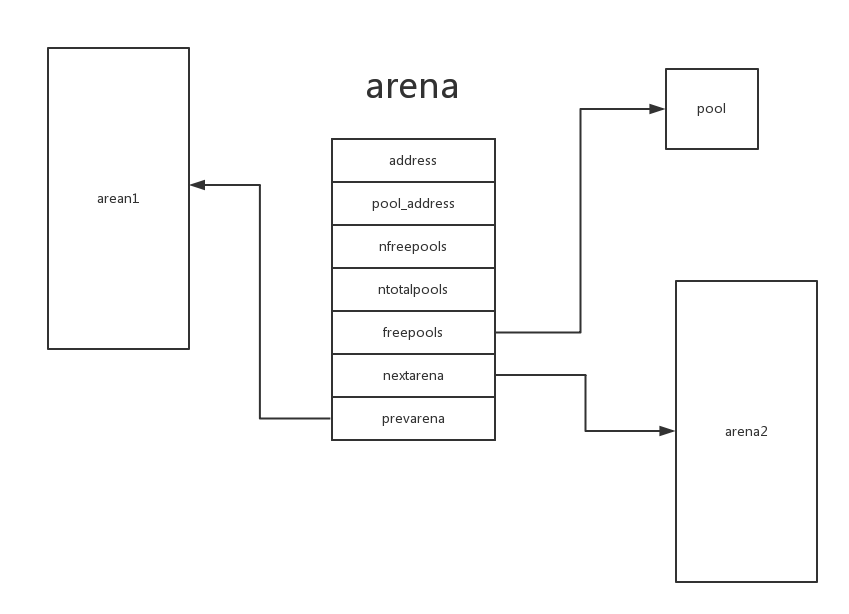
arena的两种状态
arena存在两种状态: 未使用(没有建立联系)/可用(建立了联系)
全局由两个链表维护着
/* The head of the singly-linked, NULL-terminated list of available
* arena_objects.
*/
// 单链表
static struct arena_object* unused_arena_objects = NULL;
/* The head of the doubly-linked, NULL-terminated at each end, list of
* arena_objects associated with arenas that have pools available.
*/
// 双向链表
static struct arena_object* usable_arenas = NULL;
arena的初始化
首先, 来看下初始化相关的一些参数定义
代码obmalloc.c
/* Array of objects used to track chunks of memory (arenas). */
// arena_object 数组
static struct arena_object* arenas = NULL;
/* Number of slots currently allocated in the `arenas` vector. */
// 当前arenas中管理的arena_object的个数, 初始化时=0
static uint maxarenas = 0;
/* How many arena_objects do we initially allocate?
* 16 = can allocate 16 arenas = 16 * ARENA_SIZE = 4MB before growing the
* `arenas` vector.
*/
// 初始化时申请的arena_object个数
#define INITIAL_ARENA_OBJECTS 16
/* Number of arenas allocated that haven't been free()'d. */
static size_t narenas_currently_allocated = 0;
/* The head of the singly-linked, NULL-terminated list of available
* arena_objects.
*/
// 未使用状态arena的单链表
static struct arena_object* unused_arena_objects = NULL;
/* The head of the doubly-linked, NULL-terminated at each end, list of
* arena_objects associated with arenas that have pools available.
*/
// 可用状态arena的双向链表
static struct arena_object* usable_arenas = NULL;
然后, 看下obmalloc.c中arena初始化的代码
/* Allocate a new arena. If we run out of memory, return NULL. Else
* allocate a new arena, and return the address of an arena_object
* describing the new arena. It's expected that the caller will set
* `usable_arenas` to the return value.
*/
static struct arena_object*
new_arena(void)
{
struct arena_object* arenaobj;
uint excess; /* number of bytes above pool alignment */
void *address;
int err;
// 判断是否需要扩充"未使用"的arena_object列表
if (unused_arena_objects == NULL) {
uint i;
uint numarenas;
size_t nbytes;
/* Double the number of arena objects on each allocation.
* Note that it's possible for `numarenas` to overflow.
*/
// 确定需要申请的个数, 首次初始化, 16, 之后每次翻倍
numarenas = maxarenas ? maxarenas << 1 : INITIAL_ARENA_OBJECTS;
if (numarenas <= maxarenas)
return NULL; /* overflow */ //溢出了
....
nbytes = numarenas * sizeof(*arenas);
// 申请内存
arenaobj = (struct arena_object *)realloc(arenas, nbytes);
if (arenaobj == NULL)
return NULL;
arenas = arenaobj;
/* We might need to fix pointers that were copied. However,
* new_arena only gets called when all the pages in the
* previous arenas are full. Thus, there are *no* pointers
* into the old array. Thus, we don't have to worry about
* invalid pointers. Just to be sure, some asserts:
*/
assert(usable_arenas == NULL);
assert(unused_arena_objects == NULL);
// 初始化
/* Put the new arenas on the unused_arena_objects list. */
for (i = maxarenas; i < numarenas; ++i) {
arenas[i].address = 0; /* mark as unassociated */
// 新申请的一律为0, 标识着这个arena处于"未使用"
arenas[i].nextarena = i < numarenas - 1 ?
&arenas[i+1] : NULL;
}
// 将其放入unused_arena_objects链表中
// unused_arena_objects 为新分配内存空间的开头
/* Update globals. */
unused_arena_objects = &arenas[maxarenas];
// 更新数量
maxarenas = numarenas;
}
/* Take the next available arena object off the head of the list. */
assert(unused_arena_objects != NULL);
// 从unused_arena_objects中, 获取一个未使用的object
arenaobj = unused_arena_objects;
unused_arena_objects = arenaobj->nextarena; // 更新链表
// 开始处理这个 arenaobject
assert(arenaobj->address == 0);
// 申请内存, 256KB, 内存地址赋值给arena的address. 这块内存可用
#ifdef ARENAS_USE_MMAP
address = mmap(NULL, ARENA_SIZE, PROT_READ|PROT_WRITE,
MAP_PRIVATE|MAP_ANONYMOUS, -1, 0);
err = (address == MAP_FAILED);
#else
address = malloc(ARENA_SIZE);
err = (address == 0);
#endif
if (err) {
/* The allocation failed: return NULL after putting the
* arenaobj back.
*/
arenaobj->nextarena = unused_arena_objects;
unused_arena_objects = arenaobj;
return NULL;
}
arenaobj->address = (uptr)address;
++narenas_currently_allocated;
// 设置pool集合相关信息
arenaobj->freepools = NULL; // 设置为NULL, 只有在释放一个pool的时候才有用
/* pool_address <- first pool-aligned address in the arena
nfreepools <- number of whole pools that fit after alignment */
arenaobj->pool_address = (block*)arenaobj->address;
arenaobj->nfreepools = ARENA_SIZE / POOL_SIZE;
assert(POOL_SIZE * arenaobj->nfreepools == ARENA_SIZE);
// 将pool的起始地址调整为系统页的边界
// 申请到 256KB, 放弃了一些内存, 而将可使用的内存边界pool_address调整到了与系统页对齐
excess = (uint)(arenaobj->address & POOL_SIZE_MASK);
if (excess != 0) {
--arenaobj->nfreepools;
arenaobj->pool_address += POOL_SIZE - excess;
}
arenaobj->ntotalpools = arenaobj->nfreepools;
return arenaobj;
}
图示: 初始化arenas数组, 初始化后的所有arena都在unused_arena_objects单链表里面
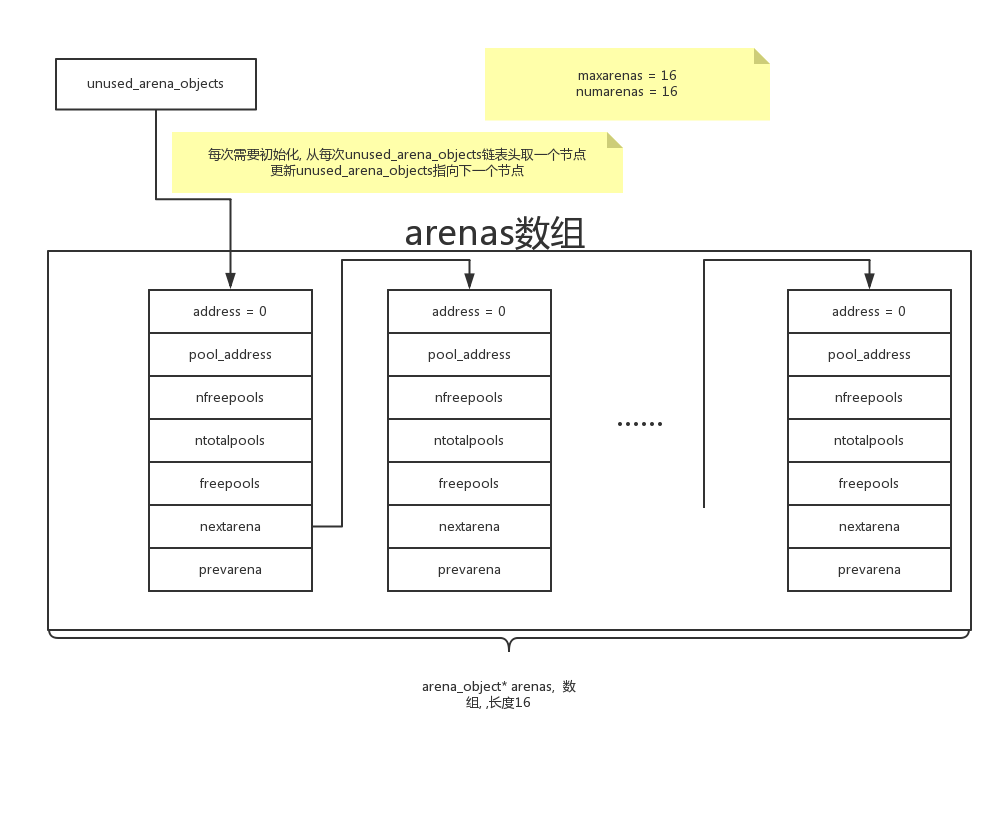
图示: 从arenas取一个arena进行初始化
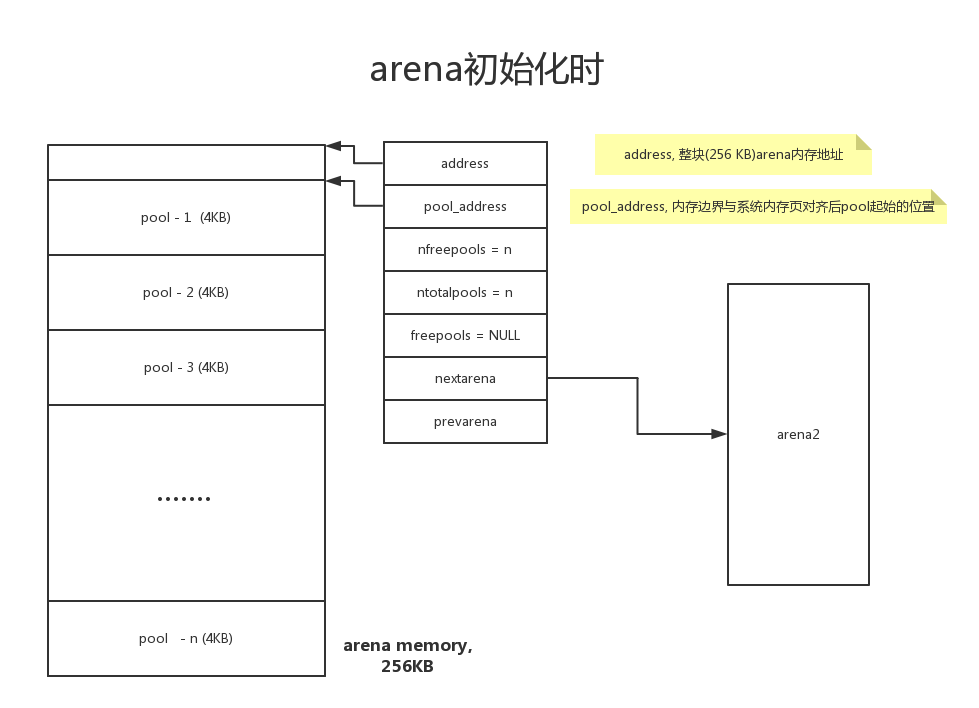
没有可用的arena?
此时
// 判断成立
if (unused_arena_objects == NULL) {
....
// 确定需要申请的个数, 首次初始化, 16, 之后每次翻倍
numarenas = maxarenas ? maxarenas << 1 : INITIAL_ARENA_OBJECTS;
然后, 假设第一次分配了16个, 发现没有arena之后, 第二次处理结果: numarenas = 32
即, 数组扩大了一倍
arena分配
new了一个全新的 arena之后,
void *
PyObject_Malloc(size_t nbytes)
{
// 刚开始没有可用的arena
if (usable_arenas == NULL) {
// new一个, 作为双向链表的表头
usable_arenas = new_arena();
if (usable_arenas == NULL) {
UNLOCK();
goto redirect;
}
usable_arenas->nextarena =
usable_arenas->prevarena = NULL;
}
.......
// 从arena中获取一个pool
pool = (poolp)usable_arenas->pool_address;
assert((block*)pool <= (block*)usable_arenas->address +
ARENA_SIZE - POOL_SIZE);
pool->arenaindex = usable_arenas - arenas;
assert(&arenas[pool->arenaindex] == usable_arenas);
pool->szidx = DUMMY_SIZE_IDX;
// 更新 pool_address 向下一个节点
usable_arenas->pool_address += POOL_SIZE;
// 可用节点数量-1
--usable_arenas->nfreepools;
}
图示: 从全新的arena中获取一个pool
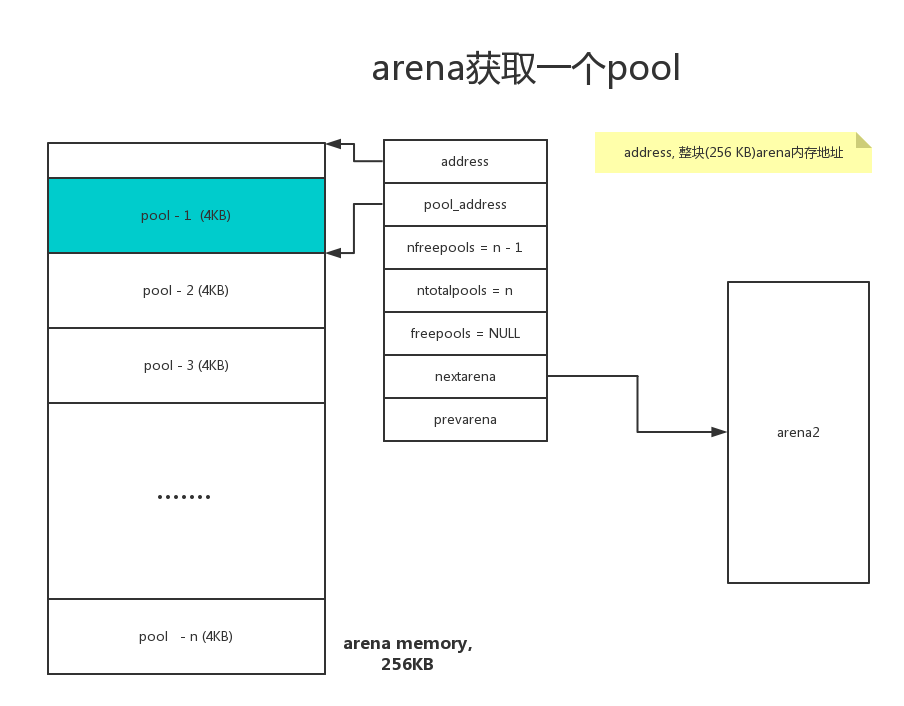
假设arena是旧的, 怎么分配的pool
pool = usable_arenas->freepools;
if (pool != NULL) {
这个arena->freepools是何方神圣?
当arena中一整块pool被释放的时候
void
PyObject_Free(void *p)
{
struct arena_object* ao;
uint nf; /* ao->nfreepools */
/* Link the pool to freepools. This is a singly-linked
* list, and pool->prevpool isn't used there.
*/
ao = &arenas[pool->arenaindex];
pool->nextpool = ao->freepools;
ao->freepools = pool;
nf = ++ao->nfreepools;
也就是说, 在pool整块被释放的时候, 会将pool加入到arena->freepools作为单链表的表头, 然后, 在从非全新arena中分配pool时, 优先从arena->freepools里面取, 如果取不到, 再从arena内存块里面获取
图示
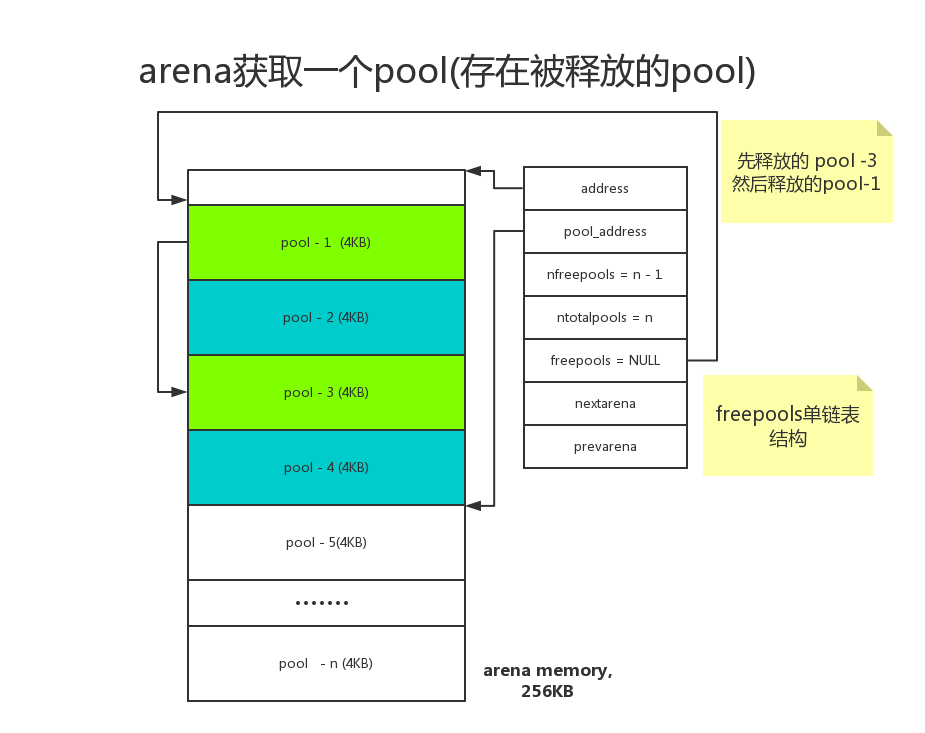
一个arena满了之后呢
很自然, 从下一个arena中获取
void *
PyObject_Malloc(size_t nbytes)
{
// 当发现用完了最后一个pool!!!!!!!!!!!
// nfreepools = 0
if (usable_arenas->nfreepools == 0) {
assert(usable_arenas->nextarena == NULL ||
usable_arenas->nextarena->prevarena ==
usable_arenas);
/* Unlink the arena: it is completely allocated. */
// 找到下一个节点!
usable_arenas = usable_arenas->nextarena;
// 右下一个
if (usable_arenas != NULL) {
usable_arenas->prevarena = NULL; // 更新下一个节点的prevarens
assert(usable_arenas->address != 0);
}
// 没有下一个, 此时 usable_arenas = NULL, 下次进行内存分配的时候, 就会从arenas数组中取一个
}
}
注意: 这里有个逻辑, 就是每分配一个pool, 就检查是不是用到了最后一个, 如果是, 需要变更usable_arenas到下一个可用的节点, 如果没有可用的, 那么下次进行内存分配的时候, 会判定从arenas数组中取一个
arena回收
内存分配和回收最小单位是block, 当一个block被回收的时候, 可能触发pool被回收, pool被回收, 将会触发arena的回收机制
四种情况
1. arena中所有pool都是闲置的(empty), 将arena内存释放, 返回给操作系统
2. 如果arena中之前所有的pool都是占用的(used), 现在释放了一个pool(empty), 需要将 arena加入到usable_arenas, 会加入链表表头
3. 如果arena中empty的pool个数n, 则从useable_arenas开始寻找可以插入的位置. 将arena插入. (useable_arenas是一个有序链表, 按empty pool的个数, 保证empty pool数量越多, 被使用的几率越小, 最终被整体释放的机会越大)
4. 其他情况, 不对arena 进行处理
具体可以看PyObject_Free的代码
内存分配步骤
好的, 到这里, 我们已经知道了block和pool的关系(包括pool怎么管理block的), 以及arena和pool的关系(怎么从arena中拉到可用的pool)
那么, 在分析PyObject_Malloc(size_t nbytes)如何进行内存分配的时候, 我们就刨除掉这些管理代码
关注: 如何寻找得到一块可用的nbytes的block内存
其实代码那么多, 寻址得到对应的block也就这么几行代码, 其他代码都是pool没有, 找arena, 申请arena, arena没有, 找arenas, 最终的到一块pool, 初始化, 返回第一个block
如果有的情况, 用现成的
pool = usedpools[size + size];
if pool可用:
pool 没满, 取一个block返回
pool 满了, 从下一个pool取一个block返回
否则:
获取arena, 从里面初始化一个pool, 拿到第一个block, 返回
从上面这个判断逻辑来看, 内存分配其实主要操作的是pool, 跟arena并不是基本的操作单元(只是用来管理pool的)
结论: 进行内存分配和销毁, 所有操作都是在pool上进行的
usedpools 是什么鬼? 其实是可用pool缓冲池, 后面说
内存池
arena 内存池的大小
取决于用户, Python提供的编译符号, 用于决定是否控制
obmalloc.c
#ifdef WITH_MEMORY_LIMITS
#ifndef SMALL_MEMORY_LIMIT
#define SMALL_MEMORY_LIMIT (64 * 1024 * 1024) /* 64 MB -- more? */
#endif
#endif
#ifdef WITH_MEMORY_LIMITS
#define MAX_ARENAS (SMALL_MEMORY_LIMIT / ARENA_SIZE)
#endif
具体使用中, python并不直接与arenas和arena打交道, 当Python申请内存时, 最基本的操作单元并不是arena, 而是pool
问题: pool中所有block的size一样, 但是在arena中, 每个pool的size都可能不一样, 那么最终这些pool是怎么维护的? 怎么根据大小找到需要的block所在的pool? => usedpools
pool在内存池中的三种状态
1. used状态: pool中至少有一个block已经被使用, 并且至少有一个block未被使用. 这种状态的pool受控于Python内部维护的usedpool数组
2. full状态: pool中所有的block都已经被使用, 这种状态的pool在arena中, 但不在arena的freepools链表中
处于full的pool各自独立, 不会被链表维护起来
3. empty状态: pool中所有block都未被使用, 处于这个状态的pool的集合通过其pool_header中的nextpool构成一个链表, 链表的表头是arena_object中的freepools
usedpools
usedpools数组: 维护着所有处于used状态的pool, 当申请内存的时候, 会通过usedpools寻找到一块可用的(处于used状态的)pool, 从中分配一个block
结构:
#define SMALL_REQUEST_THRESHOLD 512
// 512/8 = 64
#define NB_SMALL_SIZE_CLASSES (SMALL_REQUEST_THRESHOLD / ALIGNMENT)
#define PTA(x) ((poolp )((uchar *)&(usedpools[2*(x)]) - 2*sizeof(block *)))
#define PT(x) PTA(x), PTA(x)
// 2 * ((64 + 7) / 8) * 8 = 128, 大小为128的数组
static poolp usedpools[2 * ((NB_SMALL_SIZE_CLASSES + 7) / 8) * 8] = {
PT(0), PT(1), PT(2), PT(3), PT(4), PT(5), PT(6), PT(7)
#if NB_SMALL_SIZE_CLASSES > 8
, PT(8), PT(9), PT(10), PT(11), PT(12), PT(13), PT(14), PT(15)
#if NB_SMALL_SIZE_CLASSES > 16
, PT(16), PT(17), PT(18), PT(19), PT(20), PT(21), PT(22), PT(23)
#if NB_SMALL_SIZE_CLASSES > 24
, PT(24), PT(25), PT(26), PT(27), PT(28), PT(29), PT(30), PT(31)
#if NB_SMALL_SIZE_CLASSES > 32
, PT(32), PT(33), PT(34), PT(35), PT(36), PT(37), PT(38), PT(39)
#if NB_SMALL_SIZE_CLASSES > 40
, PT(40), PT(41), PT(42), PT(43), PT(44), PT(45), PT(46), PT(47)
#if NB_SMALL_SIZE_CLASSES > 48
, PT(48), PT(49), PT(50), PT(51), PT(52), PT(53), PT(54), PT(55)
#if NB_SMALL_SIZE_CLASSES > 56
, PT(56), PT(57), PT(58), PT(59), PT(60), PT(61), PT(62), PT(63)
#if NB_SMALL_SIZE_CLASSES > 64
#error "NB_SMALL_SIZE_CLASSES should be less than 64"
#endif /* NB_SMALL_SIZE_CLASSES > 64 */
#endif /* NB_SMALL_SIZE_CLASSES > 56 */
#endif /* NB_SMALL_SIZE_CLASSES > 48 */
#endif /* NB_SMALL_SIZE_CLASSES > 40 */
#endif /* NB_SMALL_SIZE_CLASSES > 32 */
#endif /* NB_SMALL_SIZE_CLASSES > 24 */
#endif /* NB_SMALL_SIZE_CLASSES > 16 */
#endif /* NB_SMALL_SIZE_CLASSES > 8 */
};
即
// 得到usedpools数组
static poolp usedpools[128] = {
PTA(0), PTA(0), PTA(1), PTA(1), PTA(2), PTA(2), PTA(3), PTA(3),
....
PTA(63), PTA(63)
}
解开看(obmalloc.c)
typedef uchar block;
/* Pool for small blocks. */
struct pool_header {
union { block *_padding;
uint count; } ref; /* number of allocated blocks */
block *freeblock; /* pool's free list head */
struct pool_header *nextpool; /* next pool of this size class */
struct pool_header *prevpool; /* previous pool "" */
uint arenaindex; /* index into arenas of base adr */
uint szidx; /* block size class index */
uint nextoffset; /* bytes to virgin block */
uint maxnextoffset; /* largest valid nextoffset */
};
typedef struct pool_header *poolp;
usedpools[0] = PTA(0) = ((poolp )((uchar *)&(usedpools[0]) - 2*sizeof(block *)))
usedpools[1] = PTA(0) = ((poolp )((uchar *)&(usedpools[0]) - 2*sizeof(block *)))
*p = usedpools[0] => p->nextpool and p->prevpool are both p
为了看懂这步的trick, 心好累>_<#
直接上图
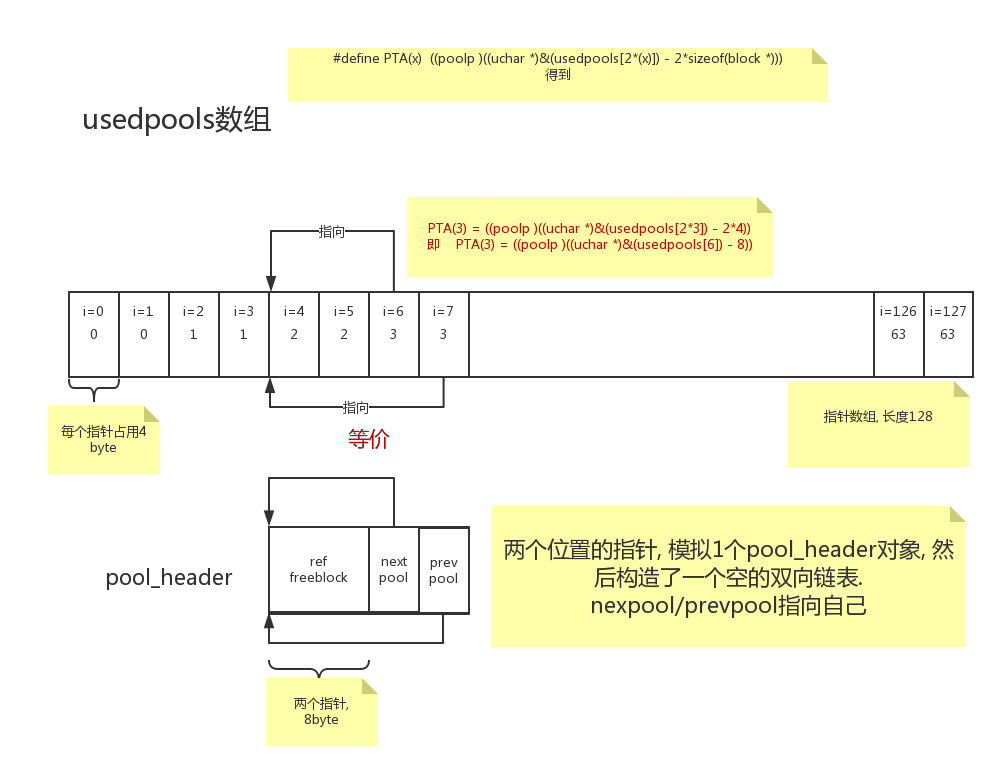
new一个pool时维护
init获得的情况, 其实就是将刚刚从arena中获取的pool加入到 usedpools 对应的双向链表中, 然后初始化, 然后返回block
init_pool:
/* Frontlink to used pools. */
// 1. 获取得到usedpools链表头
next = usedpools[size + size]; /* == prev */
// 2. 将新的pool加入到双向链表
pool->nextpool = next;
pool->prevpool = next;
next->nextpool = pool;
next->prevpool = pool;
pool->ref.count = 1;
// 3. 后面的是具体pool和block的了
if (pool->szidx == size) {
/* Luckily, this pool last contained blocks
* of the same size class, so its header
* and free list are already initialized.
*/
bp = pool->freeblock;
pool->freeblock = *(block **)bp;
UNLOCK();
return (void *)bp;
}
/*
* Initialize the pool header, set up the free list to
* contain just the second block, and return the first
* block.
*/
pool->szidx = size;
size = INDEX2SIZE(size);
bp = (block *)pool + POOL_OVERHEAD;
pool->nextoffset = POOL_OVERHEAD + (size << 1);
pool->maxnextoffset = POOL_SIZE - size;
pool->freeblock = bp + size;
*(block **)(pool->freeblock) = NULL;
UNLOCK();
return (void *)bp; // here
}
从现有pool中获取block
从现有的pool, 其实就是 usedpools得到双向链表头部, 判断是不是空链表, 不是的话代表有可用的pool, 直接从里面获取
if ((nbytes - 1) < SMALL_REQUEST_THRESHOLD) {
LOCK();
/*
* Most frequent paths first
*/
size = (uint)(nbytes - 1) >> ALIGNMENT_SHIFT;
pool = usedpools[size + size];
// 注意这里的判断, pool != pool-> nextpool 表示得到的链表不是空的
if (pool != pool->nextpool) {
/*
* There is a used pool for this size class.
* Pick up the head block of its free list.
*/
++pool->ref.count;
bp = pool->freeblock;
assert(bp != NULL);
if ((pool->freeblock = *(block **)bp) != NULL) {
UNLOCK();
return (void *)bp;
}
/*
* Reached the end of the free list, try to extend it.
*/
if (pool->nextoffset <= pool->maxnextoffset) {
/* There is room for another block. */
pool->freeblock = (block*)pool +
pool->nextoffset;
pool->nextoffset += INDEX2SIZE(size);
*(block **)(pool->freeblock) = NULL;
UNLOCK();
return (void *)bp;
}
/* Pool is full, unlink from used pools. */
next = pool->nextpool;
pool = pool->prevpool;
next->prevpool = pool;
pool->nextpool = next;
UNLOCK();
return (void *)bp; // here
}
全局结构
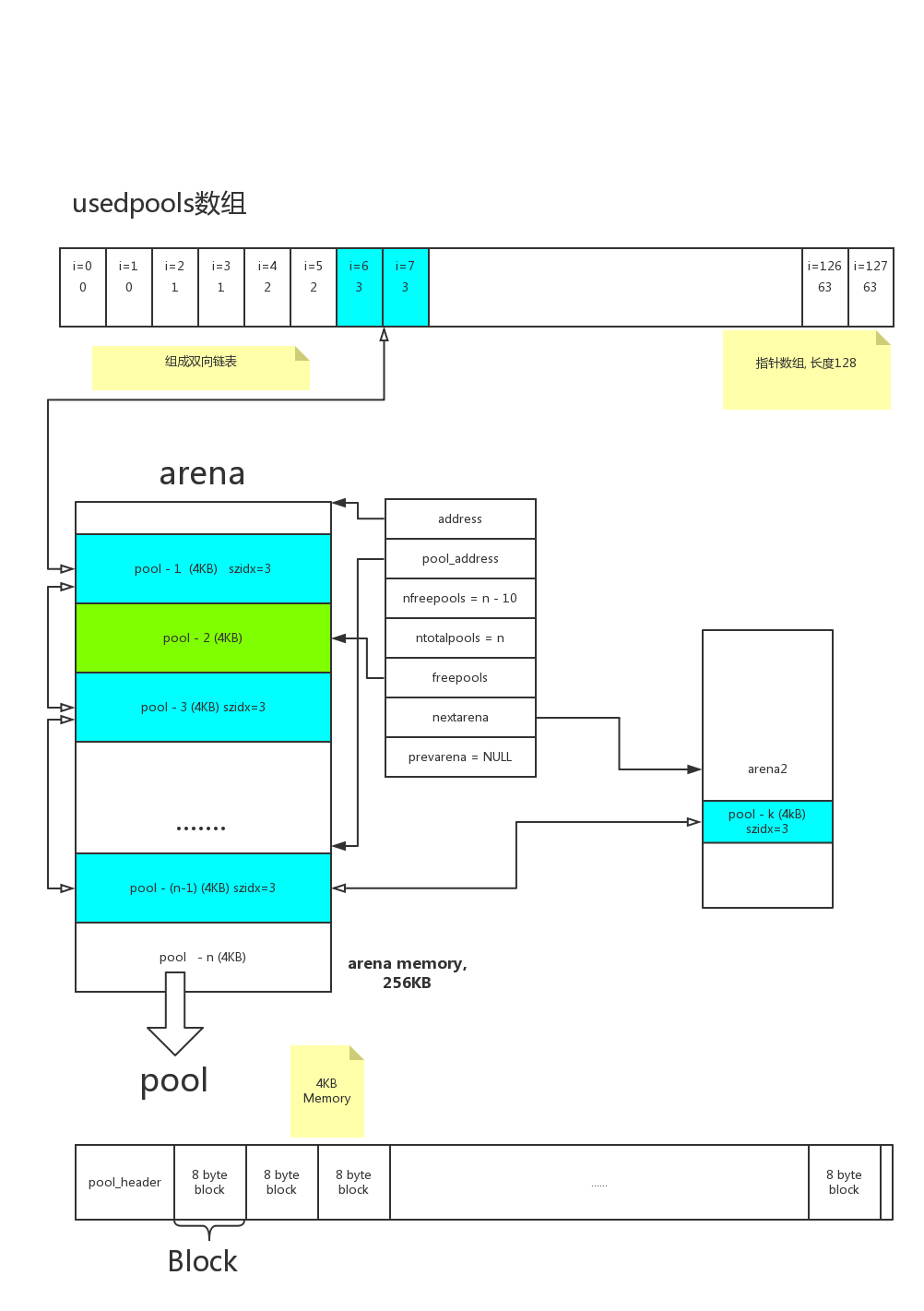
先这样吧, Python中整个内存池基本结构和机制大概如此, 是不是发现有好多数组/链表等等, 在分配/回收上处理下做成各种池…..
后面还有内存相关的就是垃圾收集了, 后面再说了吧
wklken
2015-08-29